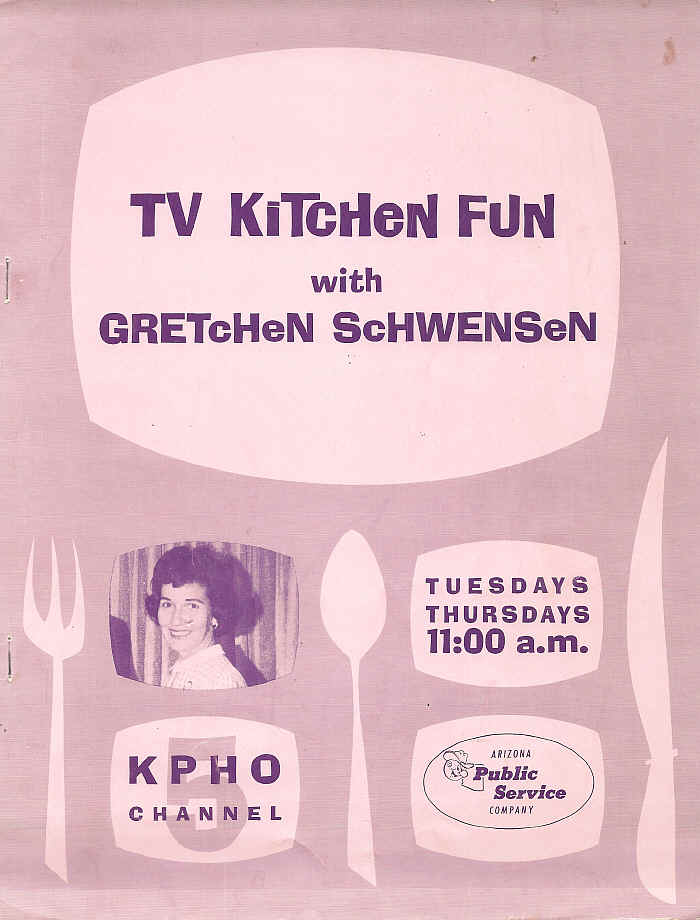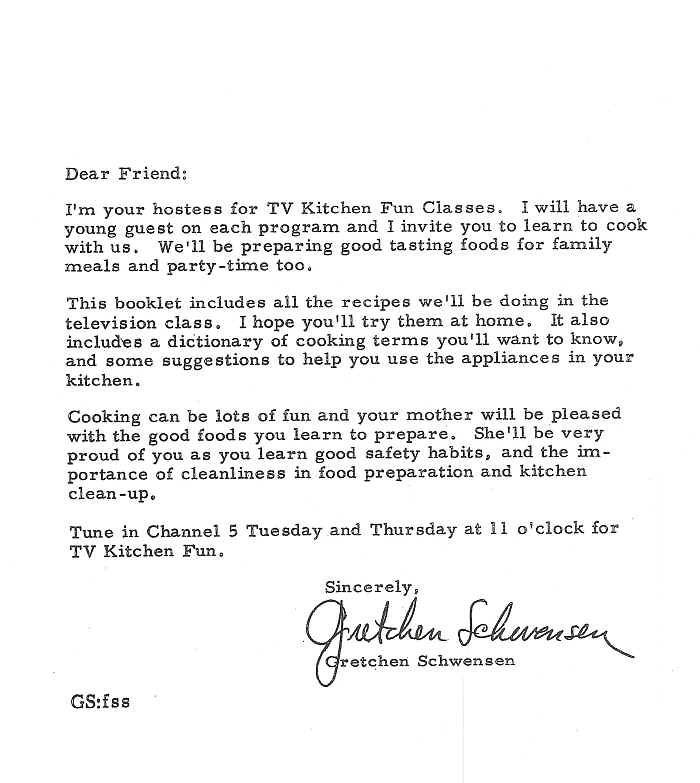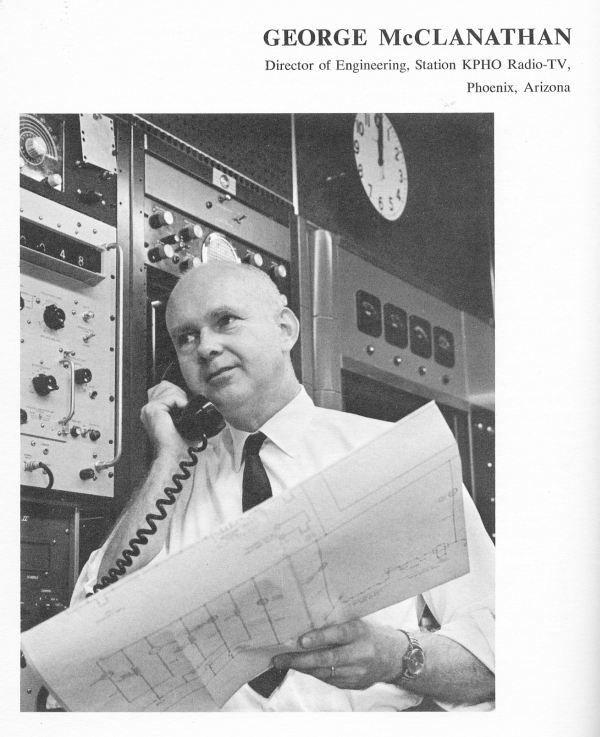|
KPHO-TV Phoenix Arizona |
||||||||||||||||||||||||||||||||||||||||||||
|
ENGINEERING
Careers in Broadcasting 1961
Author John H. Lerch (Editor actually) a chapter on and by - GEORGE McCLANATHAN Director of Engineering, Station KPHO Radio-TV, Phoenix, Arizona called... Outlook for engineers »»»»»»»»»»)
Prelude- This book was contributed to SMECC by Buck Memorial
Library Illinois Wesleyan University. It is a great 60's period
book with all the careers listed in broadcasting and written by
people like Goldenson of ABC, Sarnoff of NBC Lowell Thomas, Hugh
Downs etc.... and as I look though I discover...GEORGE
McCLANATHAN - Director of Engineering, Station KPHO Radio-TV,
Phoenix, Arizon a with a chapter entitled "Outlook
for engineers"
The rights to this publication were owned
Appleton-Century-Crofts who was a division of Meredith
Publishing Company. (Yes the same Meredith that owns KPHO!)
Well Meredith Publishing Company sold Appleton-Century-Crofts to
Pearson Education.... I called Pearson and they showed no
ownership of book... but they went to the contracts
department and found it was reverted back to the
author/editor John H. Lerch in 1974.
Well we can not find him or a relation... We would like to
so that we can reprint the entire book.
So... here is the part with our star Phoenix engineer in it! We are looking for more to add to as section to him on the SMECC website and to add section with other engineers also..... drop us a note please.... and remember.... DONT'T THROW ANYTHING AWAY!!!!! --ED SHARPE Thanks, ============================================== |
||||||||||||||||||||||||||||||||||||||||||||
 
|
||||||||||||||||||||||||||||||||||||||||||||
KPHO-TV
From Wikipedia, the free encyclopedia
KPHO-TV, channel 5, is a CBS-affiliate television station located in Phoenix, Arizona, USA. KPHO-TV is owned by the Meredith Corporation, and has its studios located on Black Canyon Highway in the Alhambra Village section of Phoenix, with its transmitter located on South Mountain in Phoenix. KPHO extends its signal throughout northern Arizona by way of more than a dozen translators.
HistoryKPHO is Arizona's oldest television station, signing on December 4, 1949.[1] It was originally owned by a group of entrepreneurs—one of whom, John Mullins, would later launch KBTV (now KUSA-TV) in Denver, Colorado. The original group also included shareholders of Phoenix Broadcasting, which operated KPHO radio (910 AM, now KFYI at AM 550); the television station, originally known as KTLX, had its call letters changed to the current KPHO-TV shortly before it took to the air. It originally broadcast from studios at the Hotel Westward Ho in downtown Phoenix. The Meredith Corporation purchased the KPHO stations on June 25, 1952.[2] As the only television station in Phoenix during the first three-and-a-half years of operation, it carried programming from all four networks of the time: CBS (primary affiliation), NBC, ABC and the now-defunct DuMont Television Network.[2] NBC disappeared from KPHO's schedule when KTYL-TV (channel 12, now KPNX) signed on April 23, 1953, followed by CBS when KOOL-TV (channel 10, now KSAZ-TV) signed on a few months later, on October 24. KPHO remained a dual ABC-DuMont affiliate (with ABC programming shared between KPHO-TV and KOOL-TV) until February 28, 1955, when KTVK (channel 3) signed on and took the ABC affiliation full-time. KPHO became an independent station when DuMont ceased network operations in 1956. During the late 1950s, the station was briefly affiliated with the NTA Film Network.[3] KPHO-TV lost its sister station when Meredith sold KPHO radio in 1971. That same year, channel 5 moved to its current facility on Black Canyon Highway. As an independent station, channel 5 programmed a schedule of movies, off-network series, and a nightly newscast at 9:00 p.m. It also produced The Wallace and Ladmo Show, a children's show which aired weekday mornings from 1954 until 1989 (when it was decided by the stars of the show that it would end). During the 1970s, KPHO became a regional superstation available on cable in much of Arizona and New Mexico, as well as parts of California, Utah and Nevada. KPHO was the sole independent English-language television station in Phoenix until 1979, when KNXV-TV (channel 15) signed on with general entertainment during the day and subscription TV at night. (KNXV became a full-time general entertainment station by 1983.) Even though KPHO was the leading independent station in the market, the new Fox Broadcasting Company opted to affiliate with KNXV in 1986 after the E. W. Scripps Company purchased the station, promising to upgrade its syndicated programming and to launch a newscast. Although it never did begin a newscast, landing the Fox affiliation made KNXV a very strong competitor against KPHO. By the late 1980s, News 5, its news operation, comprised two newscasts: a weekday 11:30 newscast and Arizona's first primetime newscast at 9:30pm (years before KSAZ became a Fox station with a 9pm newscast). In 1994, as part of a massive wave of affiliation switches throughout the country, KSAZ announced it was dropping CBS in favor of Fox as a result of its pending sale to New World Communications. CBS briefly wooed KTVK, whose then locally-based ownership declined in hopes of renewing with ABC. CBS then approached KPHO, since it was the only non-Big Three station in town that had a functioning news department. On June 30, 1994, CBS agreed to a long-term contract with Meredith, allowing KPHO-TV to rejoin the network 42 years after CBS moved to channel 10. The centerpiece of the deal was a renewal of CBS's affiliation with Meredith's Kansas City station, KCTV; it also called for a switch at another of KPHO-TV's sister stations, WNEM-TV in Bay City, Michigan, to CBS from NBC.[4]. (The ABC affiliation eventually went to KNXV when Scripps cut an affiliation deal which called for four of that company's non-ABC affiliates to switch to ABC; KTVK then replaced KPHO as the market's main independent station.) Phoenix was one of just four television markets where the CBS affiliation moved from one VHF station to another during the 1994 affiliation switches. KSAZ-TV evicted CBS on September 12, 1994 upon that station's sale to New World Communications becoming final. CBS then moved to KPHO at that time. Initially, KPHO continued to run a couple cartoons and a moderate number of sitcoms during local time. By January 1995, the cartoons were gone, and then the station gradually added more newscasts and talk/reality shows,[5] with the sitcoms being phased out and moved to KTVK, KUTP (channel 45), and KASW (channel 61). KPHO has generally been one of CBS's weaker affiliates after switching in 1994 due in large part to the station's lack of a strong inventory of syndicated programming although its 10 p.m. newscast took the lead among English-language stations in total households in the November 2009 sweeps period. In stark contrast, KOOL/KTSP/KSAZ had been one of CBS's strongest affiliates and was in strong second at the time of the switch. On February 24, 2009 it was announced that KPHO-TV, KTVK and KPNX would share a helicopter starting March 1, 2009.[6][7][8] On March 14, 2009, KPHO became the fourth station in Phoenix to switch to high definition newscasts. On April 1, 2009, Fox Television Stations and E. W. Scripps Company announced the creation of the Local News Service model in the Phoenix, Detroit and Tampa Markets. The service pools news gathering efforts for general market news events. Each station provides employees to the pool service in exchange for the sharing of video.[9] KPHO-TV signed on to the Phoenix LNS model shortly after the announcement.[10] ProgrammingKPHO is a typical CBS affiliate, clearing the entire network schedule and airing five hours of local news daily, complemented by syndicated fare and paid programming. KPHO airs one hour of local news at 5 p.m., so the CBS Evening News is shown at 6 p.m. instead of 5:30 p.m., when most CBS stations in the Mountain Time Zone air the network news. In addition, KPHO features the only 6:30pm local newscast in the Phoenix market. Better Arizona, a national daily lifestyle program, features locally-produced inserts. That program airs weekday mornings at 10 a.m., with The Price Is Right airing at 9 a.m. (one hour earlier than CBS's recommended time slot). Digital televisionDigital channels
Prior to 2009, a 5.3 subchannel was added for NCAA tournament coverage, with analog channel 5 breaking from 5.1 in order to create coverage of all four games. KPHO switched its analog broadcasts to a digital nightlight service at 11:59 p.m. on 12 June 2009, just minutes before the end of the day mandated by the Federal government for TV stations to cease analog transmissions across the country. KPHO continues digital broadcasts on its pre-transition channel number, 17.[11][12] However, through the use of PSIP, digital television receivers display KPHO-TV's virtual channel as 5. For 30 days after the switch to digital, KPHO's analog channels served as a "nightlight" station to remind TV viewers of the switch to digital.[13] News operationNews/station presentationNewscast titles
Station slogans
Notable on-air staff[14]Current on-air staffCurrent anchors
CBS 5 Valley Pinpoint Weather
Sports team
Reporters
Helicopter pilots/reporters(As part of a Local News Service the helicopter is shared with KTVK and KPNX and operated by Helicopters Inc.)
Notable former on-air staffDigital subchannelsOn December 20, 2006, KPHO began broadcasting CBS 5 Weather Now on digital subchannel 5.2.[15] CBS 5 Weather Now is located on Cox Communications digital channel 85, Qwest Choice TV channel 64, and CableOne Digital channel 461. RebroadcastersKPHO is rebroadcast on the following translator stations:
|
||||||||||||||||||||||||||||||||||||||||||||
References
- ^ "TV Transfers". 1972 Broadcasting Yearbook. http://www.davidgleason.com/Broadcasting%201972%20Yearbook%20Section%20Guide_files/1972%20Broadcasting%20Yearbook%20TV%20Allocation%20and%20Trsnsfers.pdf. Retrieved 2009-01-14.
- ^ a b "Early History of KPHO". KPHO-TV website. 2007-04-13. http://www.kpho.com/history/11850769/detail.html. Retrieved 2008-12-01.
- ^ "Require Prime Evening Time for NTA Films". Boxoffice: 13. November 10, 1956. http://issuu.com/boxoffice/docs/boxoffice_111056-1.
- ^ "Meredith Shifts Stations to CBS." New York Times 30 June 1994; p6
- ^ Meisler, Andy (August 29, 1994). "Murdoch's Raid Brings a Shuffling of TV Stations in Phoenix". New York Times: pp. 2. http://www.nytimes.com/1994/08/29/business/murdoch-s-raid-brings-a-shuffling-of-tv-stations-in-phoenix.html?pagewanted=1. Retrieved 2009-10-22.
- ^ "3 TV stations to share helicopter to cover the news". azcentral. February 24, 2009. http://www.azcentral.com/community/phoenix/articles/2009/02/24/20090224abrk-helicoptersharing.html. Retrieved 2009-02-25.
- ^ "Channels 5, 3, 12 To Share Chopper". KPHO. February 25, 2009. http://www.kpho.com/news/18791257/detail.html#-. Retrieved 2009-02-25.
- ^ "Phoenix TV stations to share news helicopter". KTAR. February 25, 2009. http://news.ktar.com/?nid=6&sid=1092013. Retrieved 2009-02-26.
- ^ "Fox, Scripps Create Local News Service". Broadcasting & Cable. April 1, 2009. http://www.broadcastingcable.com/article/191108-Fox_Scripps_Create_Local_News_Service.php. Retrieved 2009-05-28.
- ^ "Chicago stations join to share video crews for ENG". BroadcastEngineering. May 8, 2009. http://broadcastengineering.com/news/chicago-stations-join-0508/. Retrieved 2009-05-28.
- ^ "DTV Transition Status Report". FCC CDBS database. 2008-02-04. http://fjallfoss.fcc.gov/cgi-bin/ws.exe/prod/cdbs/forms/prod/cdbsmenu.hts?context=25&appn=101231100&formid=387&fac_num=41223. Retrieved 2008-12-01.
- ^ "DTV Tentative Channel Designations for the First and Second Rounds". FCC CDBS database. 2006-05-23. http://hraunfoss.fcc.gov/edocs_public/attachmatch/DA-06-1082A2.pdf. Retrieved 2008-12-01.
- ^ "Phoenix TV goes digital, can you still see our signal?". KNXV-TV. http://www.abc15.com/content/news/investigators/consumeralerts/story/Phoenix-TV-goes-digital-can-you-still-see-our/6imDb0puuEii2w0JzIUg0w.cspx. Retrieved 2009-06-12.
- ^ http://www.kpho.com/newsteam/index.html
- ^ "KPHO Phoenix launches 24-hour local weather channel". TVNEWSDAY. 2006-12-20. http://www.tvnewsday.com/articles/2006/12/20/daily.8/. Retrieved 2008-12-01.
External links






